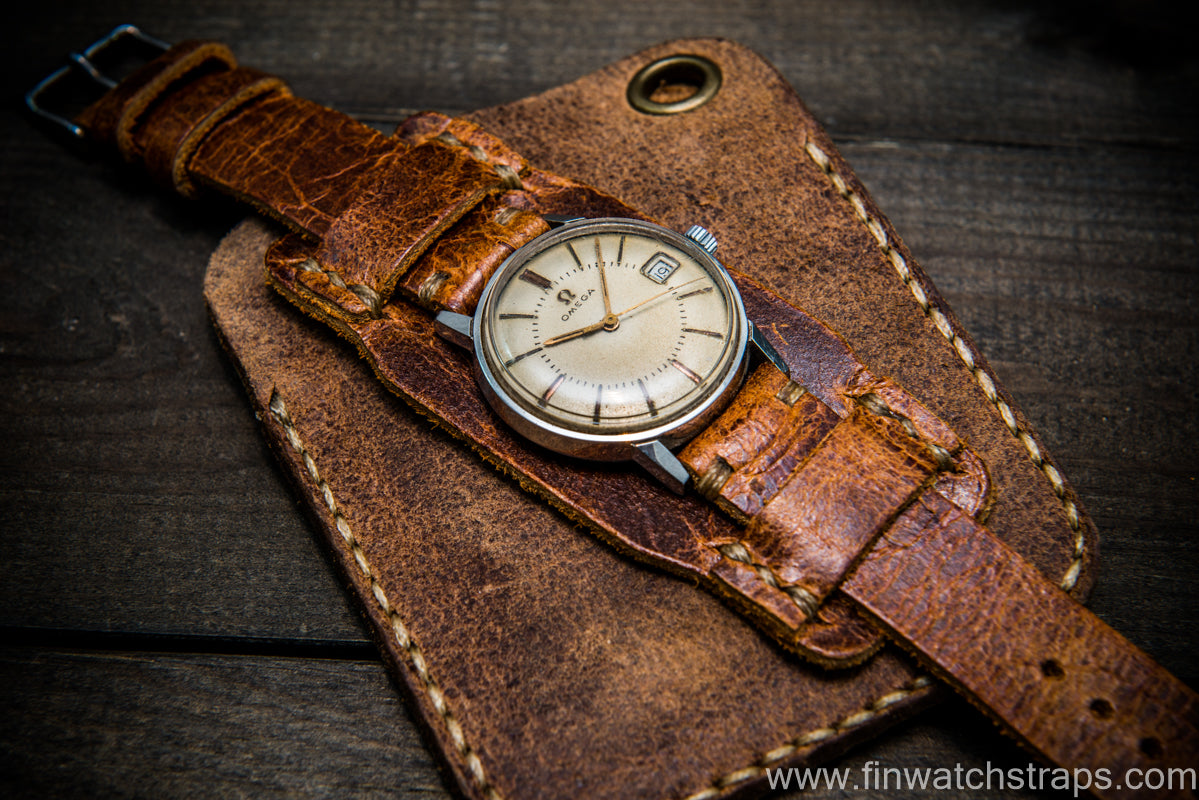What is Saddle Stitching, and Why is It Important for Strap Durability?

In the world of watch straps, every detail matters, from the choice of leather to the stitching technique. When it comes to durability and craftsmanship, one term you may often hear is the “saddle stitch.” While it might sound like a small technical aspect, saddle stitching is a hallmark of quality that has a profound impact on how long your strap will last. At FinWatchStraps, we know that a watch strap is more than just a functional accessory; it’s a statement, a testament to the craftsmanship behind it, and a companion to your timepiece.
In this article, we’ll dive deep into what saddle stitching is, how it’s done, and why it’s the preferred choice for high-quality leather watch straps. By the end, you’ll understand why this traditional hand-stitching technique is essential for those who seek durability, style, and character in their watch straps.
What is Saddle Stitching?
Saddle stitching is a method of hand-stitching leather, where each stitch is made with two needles that work in unison from opposite sides of the leather. Unlike machine stitching, where a single thread loops through the leather, saddle stitching uses two separate threads that interlock. This technique results in a stronger, more durable stitch that doesn’t unravel even if one stitch is damaged.
Originally, saddle stitching was used in leatherworking for saddles (hence the name) due to its strength and resilience. Saddles are subjected to intense wear and tear, and the stitching needed to withstand the strain of carrying a rider. Over time, leather artisans began to use this technique on other items requiring durability and longevity, including watch straps.
How is Saddle Stitching Done?
Saddle stitching is a meticulous process that requires patience, precision, and skill. Unlike machine stitching, which is quick but less durable, saddle stitching is done entirely by hand, and each stitch is individually crafted to ensure maximum strength. Here’s a closer look at how saddle stitching works.
- Preparing the Leather: The leather is first marked with evenly spaced holes, usually with a specialized tool like a pricking iron. These holes guide the needles and ensure the stitches are consistent.
- Using Two Needles: The leatherworker uses two needles threaded with the same length of waxed thread. The wax helps protect the thread from wear and creates a tighter bond with the leather.
- The Technique: Each needle is passed through the same hole from opposite sides, creating a lock in the leather. The process is repeated across the length of the strap, creating an even and robust stitch line.
- Knotting the Ends: At the end, the threads are carefully knotted and hidden between the layers of leather, giving the strap a clean, polished finish.
The result is a stitch that, if done well, will last as long as the leather itself. It’s a slow, detailed process, but it’s this craftsmanship that ensures a strap will hold up against daily wear.
Why Saddle Stitching Matters for Durability
When you invest in a quality watch strap, you want it to stand up to the rigors of everyday life. Whether you’re wearing your watch in the office, on a hike, or during your travels, the strap needs to withstand constant bending, pressure, and exposure to the elements. Here’s why saddle stitching is critical for durability.
1. Unmatched Strength
Unlike machine stitching, where a single thread loops back and forth, saddle stitching uses two independent threads. If one thread breaks, the other thread will still hold the leather together, preventing the entire stitch from unraveling. This feature is especially crucial for high-stress items like watch straps, which are constantly in motion.
2. Resilience Against Wear
Watch straps experience repeated bending and flexing, especially around the buckle area. Saddle stitching is resilient to this stress because each stitch is interlocked and secured individually. This prevents stitches from loosening over time and keeps the strap in excellent condition, even after years of use.
3. Endurance in Various Conditions
Leather watch straps are often exposed to various environmental factors, from sweat and moisture to sunlight and dust. Saddle stitching, especially when combined with waxed thread, can handle these elements without breaking down. The wax coating protects the thread, ensuring it doesn’t fray or weaken, even in humid or dusty environments.
4. Handcrafted Precision
Machine stitching is fast and consistent, but it lacks the artisanal touch that comes with hand-stitching. Saddle stitching is an art form, and each stitch is carefully crafted by hand. This level of detail not only adds to the aesthetic appeal of the strap but also ensures that every inch of stitching is inspected and perfected by a skilled artisan. For leather enthusiasts, knowing that their strap was crafted with such care enhances its value.
Aesthetics and Style: The Beauty of Saddle Stitching
It’s not all about strength—saddle stitching is also beautiful. The slight angle of each stitch, the subtle texture of the waxed thread, and the precision of the stitching line add a refined touch to the strap’s overall look. When you wear a saddle-stitched strap, you’re not just wearing a piece of leather; you’re wearing a piece of craftsmanship.
The Visual Appeal
Saddle stitching is visible and distinctive. The handcrafted look gives the strap character, setting it apart from the uniformity of machine-stitched straps. The stitching line adds contrast to the leather, highlighting its grain and color. For example, a dark brown leather strap with contrasting white saddle stitching has a classic, timeless look, while tone-on-tone stitching creates a more understated elegance.
Timelessness
Saddle stitching has a timeless appeal. It’s a technique that’s been used for centuries, and it never goes out of style. A saddle-stitched strap looks just as good on a vintage watch as it does on a modern timepiece, making it a versatile choice for any watch lover.
Saddle Stitching vs. Machine Stitching: A Comparison
So why choose saddle stitching over machine stitching? Here’s how the two methods compare in key areas:
1. Durability
Machine stitching, while efficient, is less durable. When a machine stitch breaks, the entire row can start to unravel. Saddle stitching, by contrast, uses two independent threads, so even if one thread is compromised, the other will hold.
2. Craftsmanship
Saddle stitching is a traditional, labor-intensive process that requires skill and patience. Machine stitching is faster but lacks the unique character of hand-stitching. For those who appreciate craftsmanship, saddle stitching is the preferred choice.
3. Repairability
If a saddle stitch ever does break, it’s relatively easy to repair because each stitch is independent. Machine stitching, on the other hand, is difficult to repair without restitching the entire line, which can weaken the leather over time.
Caring for a Saddle-Stitched Strap
Even the strongest stitching needs proper care to last. Here are some tips for maintaining the integrity and appearance of a saddle-stitched strap:
- Avoid Excessive Water Exposure: Leather is naturally porous, so avoid submerging your strap in water. If it does get wet, gently pat it dry and let it air dry completely.
- Clean Regularly: Use a soft cloth to wipe away dust and dirt. Avoid harsh chemicals that could damage the leather or stitching.
- Condition the Leather: Leather conditioner keeps the leather soft and prevents it from drying out. Apply conditioner every few months to maintain the strap’s quality.
- Store Properly: When not in use, store your strap in a cool, dry place away from direct sunlight to prevent fading and drying.
Taking these steps will ensure that your saddle-stitched strap stays in excellent condition for years to come.
Final Thoughts: Why Saddle Stitching is Worth the Investment
A saddle-stitched strap is an investment in quality and longevity. It’s not just about owning a watch strap; it’s about owning a piece of craftsmanship that’s built to last. For those who appreciate the finer details, saddle stitching represents a commitment to durability and tradition.
At FinWatchStraps, we’re proud to offer straps made with saddle stitching because we believe that quality craftsmanship deserves to be celebrated. So the next time you’re choosing a watch strap, consider the story behind each stitch and the artisanship that went into creating it. A saddle-stitched strap is more than a piece of leather—it’s a testament to timeless techniques and the enduring pursuit of quality

